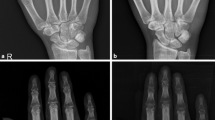Abstract
We present a case of a 20-year-old college student who had myositis ossificans traumatica develop after a fraternity hazing. The patient was struck repeatedly on both of his thighs while standing at attention, and he presented with bilateral thigh pain and stiffness 6 weeks after the incident. Physical examination revealed 130° flexion of his right knee and 50° flexion of his left knee, which had a firm end point. Radiographs showed extensive new bone located adjacent to the anterior and lateral aspects of his left femur with less involvement of his right thigh. Magnetic resonance imaging revealed considerable edema involving much of the rectus femoris and vastus lateralis of both thighs. The patient was treated with physical therapy and indomethacin for pain and inflammation control. At his 1.5-year followup, the patient’s left knee flexion had improved to 130°. Nonoperative treatment with careful followup resulted in a favorable outcome in this patient despite considerable formation of bilateral thigh myositis ossificans traumatica.





Similar content being viewed by others
References
Arrington ED, Miller MD. Skeletal muscle injuries. Orthop Clin North Am. 1995;26:411–422.
Aspelin P, Ekberg O, Thorsson O, Wilhelmsson M, Westlin N. Ultrasound examination of soft tissue injury of the lower limb in athletes. Am J Sports Med. 1992;20:601–603.
Beiner JM, Jokl P. Muscle contusion injuries: current treatment options. J Am Acad Orthop Surg. 2001;9:227–237.
Beiner JM, Jokl P. Muscle contusion injury and myositis ossificans traumatica. Clin Orthop Relat Res. 2002;403(suppl):S110–S119.
Booth DW, Westers BM. The management of athletes with myositis ossificans traumatica. Can J Sport Sci. 1989;14:10–16.
Danchik JJ, Yochum TR, Aspegren DD. Myositis ossificans traumatica. J Manipulative Physiol Ther. 1993;16:605–614.
Drane WE. Myositis ossificans and the three-phase bone scan. AJR Am J Roentgenol. 1984;142:179–180.
Ehara S, Shiraishi H, Abe M, Mizutani H. Reactive heterotopic ossification: its patterns on MRI. Clin Imaging. 1998;22:292–296.
Finkel MA. Traumatic injuries caused by hazing practices. Am J Emerg Med. 2002;20:228–233.
Fisher BD, Baracos VE, Reid DC. Effect of systemic inhibition of prostaglandin synthesis on muscle protein balance after trauma in the rat. Can J Physiol Pharmacol. 1991;69:831–836.
Huss CD, Puhl JJ. Myositis ossificans of the upper arm. Am J Sports Med. 1980;8:419–424.
Illés T, Dubousset J, Szendröi M, Fischer J. Characterization of bone forming cells in posttraumatic myositis ossificans by lectins. Pathol Res Pract. 1992;188:172–176.
Iorio R, Healy WL. Heterotopic ossification after hip and knee arthroplasty: risk factors, prevention, and treatment. J Am Acad Orthop Surg. 2002;10:409–416.
Kienapfel H, Koller M, Wüst A, Sprey C, Merte H, Engenhart-Cabillic R, Griss P. Prevention of heterotopic bone formation after total hip arthroplasty: a prospective randomised study comparing postoperative radiation therapy with indomethacin medication. Arch Orthop Trauma Surg. 1999;119:296–302.
King JB. Post-traumatic ectopic calcification in the muscles of athletes: a review. Br J Sports Med. 1998;32:287–290.
Leslie J, Taff ML, Mulvihill M. Forensic aspects of fraternity hazing. Am J Forensic Med Pathol. 1985;6:53–67.
Mishra DK, Fridén J, Schmitz MC, Lieber RL. Anti-inflammatory medication after muscle injury: a treatment resulting in short-term improvement but subsequent loss of muscle function. J Bone Joint Surg Am. 1995;77:1510–1519.
Nuwer H. Wrongs of Passage: Fraternities, Sororities, Hazing, Binge Drinking. Bloomington IN: Indiana University Press; 1999:24–59.
Ritter MA, Sieber JM. Prophylactic indomethacin for the prevention of heterotopic bone formation following total hip arthroplasty. Clin Orthop Relat Res. 1985;196:217–225.
Ryan JB, Wheeler JH, Hopkinson WJ, Arciero RA, Kolakowski KR. Quadriceps contusions: West Point update. Am J Sports Med. 1991;19:299–304.
Thorsson O, Lilja B, Nilsson P, Westlin N. Immediate external compression in the management of an acute muscle injury. Scand J Med Sci Sports. 1997;7:182–190.
Young JL, Laskowski ER, Rock MG. Thigh injuries in athletes. Mayo Clin Proc. 1993;68:1099–1106.
Author information
Authors and Affiliations
Corresponding author
Additional information
Each author certifies that he or she has no commercial associations (eg, consultancies, stock ownership, equity interest, patent/licensing arrangements, etc) that might pose a conflict of interest in connection with the submitted article.
Each author certifies that his or her institution has approved the reporting of this case report, that all investigations were conducted in conformity with ethical principles of research, and that informed consent for participation in the study was obtained.
About this article
Cite this article
Sodl, J.F., Bassora, R., Huffman, G.R. et al. Case Report. Clin Orthop Relat Res 466, 225–230 (2008). https://doi.org/10.1007/s11999-007-0005-6
Received:
Accepted:
Published:
Issue Date:
DOI: https://doi.org/10.1007/s11999-007-0005-6




